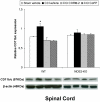Carbon monoxide reduces neuropathic pain and spinal microglial activation by inhibiting nitric oxide synthesis in mice
- PMID: 22928017
- PMCID: PMC3425507
- DOI: 10.1371/journal.pone.0043693
Carbon monoxide reduces neuropathic pain and spinal microglial activation by inhibiting nitric oxide synthesis in mice
Abstract
Background: Carbon monoxide (CO) synthesized by heme oxygenase 1 (HO-1) exerts antinociceptive effects during inflammation but its role during neuropathic pain remains unknown. Our objective is to investigate the exact contribution of CO derived from HO-1 in the modulation of neuropathic pain and the mechanisms implicated.
Methodology/principal findings: We evaluated the antiallodynic and antihyperalgesic effects of CO following sciatic nerve injury in wild type (WT) or inducible nitric oxide synthase knockout (NOS2-KO) mice using two carbon monoxide-releasing molecules (CORM-2 and CORM-3) and an HO-1 inducer (cobalt protoporphyrin IX, CoPP) daily administered from days 10 to 20 after injury. The effects of CORM-2 and CoPP on the expression of HO-1, heme oxygenase 2 (HO-2), neuronal nitric oxide synthase (NOS1) and NOS2 as well as a microglial marker (CD11b/c) were also assessed at day 20 after surgery in WT and NOS2-KO mice. In WT mice, the main neuropathic pain symptoms induced by nerve injury were significantly reduced in a time-dependent manner by treatment with CO-RMs or CoPP. Both CORM-2 and CoPP treatments increased HO-1 expression in WT mice, but only CoPP stimulated HO-1 in NOS2-KO animals. The increased expression of HO-2 induced by nerve injury in WT, but not in NOS2-KO mice, remains unaltered by CORM-2 or CoPP treatments. In contrast, the over-expression of CD11b/c, NOS1 and NOS2 induced by nerve injury in WT, but not in NOS2-KO mice, were significantly decreased by both CORM-2 and CoPP treatments. These data indicate that CO alleviates neuropathic pain through the reduction of spinal microglial activation and NOS1/NOS2 over-expression.
Conclusions/significance: This study reports that an interaction between the CO and nitric oxide (NO) systems is taking place following sciatic nerve injury and reveals that increasing the exogenous (CO-RMs) or endogenous (CoPP) production of CO may represent a novel strategy for the treatment of neuropathic pain.
Conflict of interest statement
Figures





References
-
- Watkins LR, Maier SF (2003) Glia: a novel drug discovery target for clinical pain. Nat Rev Drug Discov 2: 973–985. - PubMed
-
- La Buda CJ, Koblish M, Tuthill P, Dolle RE, Little PJ (2006) Antinociceptive activity of the selective iNOS inhibitor AR-C102222 in rodent models of inflammatory, neuropathic and post-operative pain. Eur J Pain 10: 505–512. - PubMed
-
- Meller ST, Pechman PS, Gebhart GF, Maves TJ (1992) Nitric oxide mediates the thermal hyperalgesia produced in a model of neuropathic pain in the rat. Neuroscience 50: 7–10. - PubMed
-
- De Alba J, Clayton NM, Collins SD, Colthup P, Chessell I, et al. (2006) GW274150, a novel and highly selective inhibitor of the inducible isoform of nitric oxide synthase (iNOS), shows analgesic effects in rat models of inflammatory and neuropathic pain. Pain 120: 170–181. - PubMed
Publication types
MeSH terms
Substances
LinkOut - more resources
Full Text Sources
Other Literature Sources
Molecular Biology Databases
Research Materials

